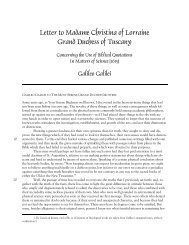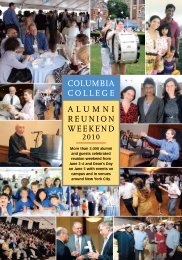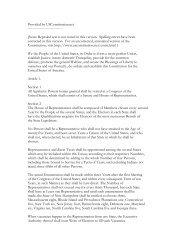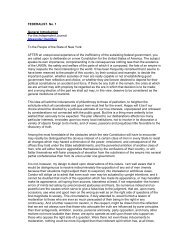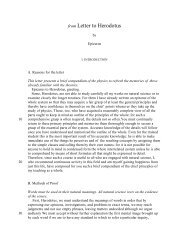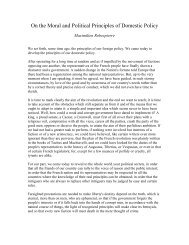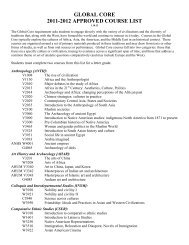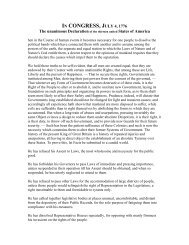spring 2012 columbia college women
spring 2012 columbia college women
spring 2012 columbia college women
Create successful ePaper yourself
Turn your PDF publications into a flip-book with our unique Google optimized e-Paper software.
SPRING <strong>2012</strong>COLUMBIA COLLEGE WOMEN25 Years of Coeducation
EVENTSEmbracing Change ... or Not?On February 29, CCW sponsored an engaging and timely panel discussionand series of workshops that focused on responding to change in our lives.“Embracing Change ... Or Not?” was held at AXA Financial in midtown and waswell attended by alumnae and current students from several Columbia schools.PHOTO: D. FongLife Changes: The NextStepEVENTSThis is a program that helps people find new waysof thinking about the next step in their lives-bothprofessionally and personally. Originally offeredat The Aspen Institute, workshops use poetry toexplore what we need at various stages of ourlives to feel fulfilled.Dr. Laura Brumberg, CC ’87 and chair of theCCW membership committee, moderated a panelof experts who discussed positive approaches tochange in all aspects of one’s life, from the personalto the professional. The panelists supported themessage that change is something to be embracedrather than feared. They advocated a proactiveapproach to prepare for and initiate change.Siheun Song, CC ’07 gives the opening remarks.PHOTO: D. FongPHOTO: S. SongAttendees were then treated to artisanal cheesefrom Luigi Guffanti Formaggi as well as dinner andsocializing before separating into smaller groups forindividual workshops led by each of the panelists.The workshops focused on mentally and physicallyadapting to change.PHOTOS: D. FongThe Embracing Change panelists and moderator (pictured left toright) - Linda, Mari, Laura and Tina.Tina Fong, BC ’87, a Guild Certified FeldenkraisTeacher ® led the Feldenkrais workshop, whichhelped one group of attendees try to increasetheir awareness by reconnecting with their naturalmovements. Dr. Linda Lehrer, the Director ofNew York Public Programs at the Aspen Instituteand also a life coach, used poetry to assist anothergroup on the path to thinking differently aboutthe way they adapt to change. Mari Miyoshi, alicensed Occupational Therapist, used Brain Gym ®to help the third group learn to train their bodies torespond to change through a variety of breathingand physical exercises.Overall, participants said that they left feelinginspired to use their new tools and techniques toembark on transformation. Many people expressedsupport for the program and hoped it would beoffered again in order for them to try the differentworkshops that they had not been able to attend.It certainly seems that Columbia alumnae haveresponded to the program’s title in the affirmative!— Virginia Harnisch, CC ’87“Be the change that you wish tosee in the world.” -- Gandhi.The Next Step is about change. It is aboutmovement. As we move along in our lives,the scenery changes and the road changes. Weexperience things, learn things, lose and gainthings. We grow older. Each of these changesopens another phase of our lives, requiring newways of thinking and of looking at ourselves andour surroundings.The phase of life addressed in this program isnot connected to a particular age, nor is it thenatural consequence of growing older. Somepeople get to this phase through a life-changingevent: divorce, illness, the loss of a job, orretirement. For others the path is less obvious-asense of restlessness, discontent. Howeverthey get there, it is at this point people begin toquestion the significance of life: What is it allabout? What am I here for? What is a “good”life?The Next Step helps participants explore what itis they really need, what they feel is importantand what is next in their lives. Discussions coversuch issues as:·How to find out what you really want·Building up the muscles of change·Turning up the volume of your lifeThrough a combination of dialogue andrelaxation, participants take some deep breathsand begin to look at their life-and their optionsinnew ways.— Linda Lehrer, Ph.D.6 7
EVENTSWhat is “Brain Gym ® ”?EVENTSBrain Gym movements, exercises, or activities refer to the original 26 Brain Gym movements, sometimesabbreviated as the 26. These activities recall the movements naturally done during the first years of lifewhen learning to coordinate the eyes, ears, hands, and whole body. The twenty-six activities, alongwith a program for “learning through movement” were developed by educator and reading specialistPaul E. Dennison and his wife and colleague, Gail E. Dennison who say that the interdependenceof movement, cognition, and applied learning is the basis of their work. For over 20 years, clients,teachers, and students all over the world have been reporting on the effectiveness of these simpleactivities.These movements work so well, they often bring about dramatic improvements in areas such as:• Concentration and Focus• Memory• Stress Management• Academics: reading, writing, math, test taking• Physical coordination• Relationships• Self-responsibility• Organization skills• AttitudeAll information courtesy Mari Miyoshi’s website. For information on courses in New York go to:http://braingymlearningcenternyc.weebly.com. To find additional information on Brain Gym as well as classesand practitioners in another area, please visit: www.braingym.orgPHOTOS: D. FongOrdinarily, we learn just enough to function. Forexample, we learn to use our hands well enough toeat and our legs well enough to walk. Our abilitiesto function with a greater range of ease and skill,however, remain to be developed. The FeldenkraisMethod ® teaches -- through movement -- how we canimprove our capabilities to function in our daily lives.The Feldenkrais Method ® is named after its originator,Dr. Moshe Feldenkrais, D.Sc. (c.1904-1984), aRussian born physicist, judo expert, mechanicalengineer and educator.The Feldenkrais Method ® is a form of somaticeducation that uses gentle movement and directedattention to improve movement and enhancehuman functioning. Through this Method, we canincrease our ease and range of motion, improveour flexibility and coordination, and rediscover ourinnate capacity for graceful, efficient movement.These improvements will often generalize toenhance functioning in other aspects of our lives.The Feldenkrais Method ® is expressed in twoparallel forms: Awareness Through Movement ®and Functional Integration ® . Both forms are basedon principles of physics, biomechanics and anempirical understanding of learning and humandevelopment. By expanding the self-image throughmovement sequences that bring attention to thePHOTO: S. SongWhat is the Feldenkrais Method ® ?PHOTOS: D. Fongparts of the self that are out of awareness, the Methodenables individuals to include more of themselvesin their functioning movements. Students becomemore aware of their habitual neuromuscularpatterns and rigidities and expand options fornew ways of moving. By increasing sensitivity theFeldenkrais Method ® helps us to live our lives morefully, efficiently and comfortably.In New York, you can find Feldenkrais classesin popular health clubs, acting schools, privatestudios, physical therapy offices and sometimeseven in Central Park!All information compiled by Tina Fong from theFeldenkrais NY website. For information on courses inNew York go to: http:// www.FeldenkraisNY.org.8 9
COVER ARTICLE25 Years of CoeducationIn May <strong>2012</strong>, it will have been 25 years since the graduation of the first fully coeducational class atColumbia College. In preparation for the Spring <strong>2012</strong> CCW Newsletter, which takes a brief look at thismilestone, we asked some graduates of the Columbia College Class of 1987 to share their memories onwhat it was like to attend Columbia way back then.The Columbia College Class of 1987 graduates.PHOTO: L. BrumbergOn moving into the dorms: “The dayI moved into Carmen Hall it struck methat I was part of something special.There were banners throughout thecampus welcoming the first <strong>women</strong>’sclass. A Daily News reporter followedme into my room and took picturesof me unpacking and asked mequestions about what it felt like to bepart of history. The next day the DailyNews ran an extensive article aboutthe arrival of woman at ColumbiaCollege and featured photos of myselfand other <strong>women</strong> moving into theirdorm rooms. It was very exciting!”showcasing the names of famous<strong>women</strong> writers over the malenames etched into Butler’s façade.Apparently the student had madean earlier attempt at this duringgraduation – and was nearlyarrested. Oddly there seemed tobe no awareness in the article ofthe 1987 graduation banner. Notonly have female authors not beenfully integrated into the Core, eventhe history of the original bannerhad apparently been lost less thantwo years after it appeared.COVER ARTICLEAny examination of coeducationat Columbia will turn up a mixedbag of positives and what I like to refer to as “situations that cause us to desire future change.” Speakingwith female graduates from the last 10 - 15 years, there is the sense that coeducation is so much a partof Columbia College as to be almost a non-issue. As you will see in the next article, “Coeducation andEntrepreneurship,” considerations about equality between men and <strong>women</strong> in the workplace, however,are still present and evolving.— Laura Brumberg, M.D., CC ’87“The bathrooms being fairly gross [and] I remember‘shared’ showers late at night. . . . There also usedto be a sacrifice of a ‘virgin’ on the sundial.”Best dorm story: “. . . the dead body in the rugfrom the dumpster.”Biggest change over the four years in terms ofcoeducation integration: “We started a health careprogram for <strong>women</strong> [but] we first had to build thefacility. From that, ‘Go Ask Alice’ evolved.”“. . . Don’t forget the banner placed over ButlerLibrary at graduation with <strong>women</strong> authors on it.”“I remember the banner hanging over Butler duringour graduation ceremony. I figured that listing allthose great female authors on the building wasindicative of the changes in the Core Curriculumsoon to follow. I’m still waiting for those changes.”“I was a reporter for the Spectator. During mysophomore year, I had the honor of interviewingLawrence Wein. We talked about his experiencesas a student at Columbia, his generous donation tothe Columbia athletics program and the dedicationof Wein Stadium at Baker’s Field. Mr. Wein told methat if all the <strong>women</strong> at Columbia were as prettyand smart as me, Columbia should have admitted<strong>women</strong> a long time ago. He was a charmer! Ihad material for a great story and an unforgettablememory.”While doing some research on coeducation I cameacross the 1992 - 1993 Winter edition of ColumbiaCollege Today online. The issue was examiningthe state of the College 10 years after the initialcoeducation decision. In it, Martha Howell, Ph.D.,Miriam Champion Professor of History at Columbia,described an incident in the fall of 1989 wherea female student was allowed to place a bannerPHOTOS: T. Fong10 11
COVER ARTICLECoeducation and EntrepreneurshipPHOTO: L. BrumbergAfew months ago, I saw a posting on the NYTech Meetup listserv from a fellow femaleentrepreneur. She asked if there were anyother expectant moms out there in the land of startupswho would like to meet up. The first personto respond said, essentially, that she would likelyfind very few. Mothers just were not able to devotethe time and energy needed to create a successfulstartup because of their responsibilities to theirchildren. Other entrepreneurs on the list, both maleand female, came out against this first response.They pointed out that, aside from pregnancy, therewas no reason why childcare responsibilities shouldbe delegated entirely to the mother and no reasonwhy mothers could not succeed as entrepreneurs.Being a mother who has embarked on anentrepreneurial venture of my own, I cheer on thesecond set of responses. I do this in the face ofdismal statistics that support an altogether oppositepicture. For example, only 28.7% of businesses areowned by <strong>women</strong>, and they tend to be less profitableand less enduring than those started by men (Source:Small Business Administration). Ironically, one ofthe reasons posited for this is that <strong>women</strong> often startpart-time businesses to stay in the work force andmaintain flexibility while they start their families.In my own industry, the legal profession, the statisticsare also not great. Although <strong>women</strong> make up about47.2% of law students, and 45.4% of associates atlaw firms, they make up only 19.5% of partners atlaw firms (Source: Catalyst: Women in Law in theU.S.).For my blind idealism, I blame coeducation. Giventhe success and accomplishments of other <strong>women</strong>in my class, who often beat out the men in academicsuccess and honors (our class valedictorian wasa woman), shouldn’t this same pattern of successcontinue in the business world? Indeed, withincreasing numbers of female entrepreneurs,including role models like Sheryl Sandberg, theCOO of Facebook, and Sarah Blakely, the inventorof Spanx and now a self-made billionaire, why not?To be honest, after <strong>college</strong>, I was surprised by thecontrast of how <strong>women</strong> are treated in the workforcecompared with how they are treated as students.This is something that coeducation did not prepareme for. At the first law firm where I worked, wherethere was only one female partner, I watched asthe male summer associates headed out to luncheach day with the male lawyers, while the femalesummer associates stayed in and worked as theyhad not been invited out to lunch. It seemed likethe male summer associates somehow innatelyknew how to network and meet the right mentorsfrom the start. At the second law firm where Iworked, many outstanding <strong>women</strong> attorneys whohad children did not stay. I can understand why– the juggle of childcare responsibilities and workresponsibilities is one of the hardest challenges Ihave faced since having my daughter, and it doesn’thelp that you must make certain choices that can“Although <strong>women</strong> make up about 47.2% of lawstudents, and 45.4% of associates at law firms,they make up only 19.5% of partners at law firms(Source: Catalyst: Women in Law in the U.S.).“affect your chances at partnership just as you startyour family.Still, compared to a generation ago, where, forexample, my mother was fired when she told heremployer that she was pregnant, at least there havebeen some efforts made to address the gender gapin the workforce. When, at that first law firm whereI worked, the female summer associates pointed outthe discrepancy in networking opportunities, theybegan to get invitations to lunch. Female attorneysat the firm made more of an effort to come to thesummer events, and at the end of the summer, thefirm promoted a part-time female associate to be itsfirst part-time partner. At the second law firm whereI worked, where part-time schedules were originallyA Woman’sChoice:Columbia orBarnardCOVER ARTICLEdiscretionary, the firm formalized the part-timepolicy and also allowed men to take paternity leave– which several male associates took.In reading the accounts of why Columbia Collegebecame co-ed, I find it fascinating that one of themain reasons was to attract the best and brightestpool of applicants. It only took about a hundredyears from when the trustees reluctantly agreedto form Barnard College to allow <strong>women</strong> to evenattend classes and earn a Columbia degree towhen they achieved the milestone of coeducation.I hope it does not take another 100 years for theentrepreneurial world to do the same.— Jane Chuang, CC ‘01, is a partner at Yim & Chuang LLP,a boutique law firm with practice areas in intellectual property andemployment law.I was born and raised in New York Cityand attended Dominican Academyon the Upper East Side, a <strong>college</strong>preparatory school with a strict focuson the <strong>college</strong> application process. Myfather was CC ‘79 and because of his history with Columbia, and my own research, Columbiawas my dream school. My best friend, however, decided to apply to Barnard College.PHOTO: L. BrumbergWhen my friend told me that she was applying to Barnard, but not Columbia, I was puzzled. Ourpreparatory school was an all-girls Catholic school and the thought of spending my <strong>college</strong>years at a <strong>women</strong>’s institution, even if it was across the street from a co-ed school, was notappealing. I needed a different environment from high school and welcomed Columbia’s coedstatus. On the contrary, my friend found Barnard’s focus on <strong>women</strong> to be comforting.My friend and I started our <strong>college</strong> careers at the same time and across the street from one another,but our experiences were very different. I enjoyed Columbia’s structure, housing options, and Coreclasses. She loved the nine ways of knowing, the comfort of living in all-female housing and the classofferings at Barnard. We eventually discovered that though both schools had something to offer, wehad each made the right choice for ourselves.— Zila Acosta, CC ’1112 13
COVER ARTICLEFather and Daughter: Same College,Different ExperiencesSome of my earliest memories include Columbia: a Columbia pennantabove my childhood bed and tiny Columbia plates to hold snacks. Myfather, Rolando T. Acosta, CC ‘79, Law ‘82, took me to visit campusand regaled me with stories. As a boy from the Bronx, by way ofSantiago, Dominican Republic, he told stories that depicted Columbiaas the doorway through which dreams came true and opportunitiesabounded. My father’s wish was for me to have the same amazing<strong>college</strong> experience. So, from an early age, I was set on Columbia.Naturally, I had assumed some things had changed from my father’stime there 30 years before, but I was shocked by just how much.Registration was one such change. When my father offered to bringcoffee to the registration line, I quizzically thanked him and informedhim that I had 10 minutes to get online. He panicked and offered todrive me to campus immediately, as I sat confused with my laptopawaiting my appointment. It dawned on me that my father meant aphysical line. Apparently, in his day, students lined up to register atobscene hours. Technology has certainly changed things.Many of my father’s experiences were greatly influenced by his life asa student-athlete and by the fact his was one of the last classes beforePHOTO: L. BrumbergColumbia went co-ed. I attended a co-ed Columbia and I was not anathlete. My Columbia allowed me a different dynamic in the classroom to his, with a greater variety of worldviewsand opinions.While my experience overall was different from my father’s, my time at Columbia was just as memorable. I learned,grew as a person, and was exposed to people with unique perspectives and experiences. Like him, I will never forgetmy time at Columbia; it changed me forever.— Zila Acosta, CC ’1114Scholarship Winner <strong>2012</strong>Biography & Photo: Courtesy ofNicole DelgadilloNicole Delgadillo, CC ‘15, is originally from the San Francisco Bay Area. A classicallytrained ballet dancer, Nicole has performed roles including the Sugar Plum Fairy in TheNutcracker, the Act I Pas de Trois from Swan Lake, the Summer Fairy in Cinderella andvariations from Paquita and La Fille Mal Gardee. She has studied with the Joffrey BalletSchool, Los Angeles Ballet and Kaatsbaan Extreme Ballet. In addition to dance, Nicolehas studied classical voice and participated in her high school’s choral music programfor all four years, singing in the most advanced ensemble senior year and performingin the production of Fiddler on the Roof as “Tzeitel”. At Columbia, Nicole continues topursue dance as a potential major in addition to either psychology or Latin Americanstudies. She has been a mentor with Heights-to-Heights Mentoring last fall and a coteacherteaching English as a Second Language (ESL), an experience she has loved andhopes to do again next semester. Nicole hopes that her future career will allow her tocombine her passions for dance, psychology, and the Spanish language.The CCW Scholarship FundFACT SHEETABOUT CCWColumbia College Women was founded in 1989 to buildconnections among the emerging alumnae community ofthe <strong>college</strong>. The organization was created with the goal ofbuilding new opportunities and networks among alumnae andstudents.ABOUT THE CCW SCHOLARSHIPAs undergraduate students, many of us benefited from thegenerosity of alumni through scholarships that made attendingColumbia possible. For all of us, the diversity of our classmates’perspectives enriched our Columbia experiences.CCW is committed to building networks and support forcurrent students. Through the scholarship, CCW is furtheringthis commitment by providing support for high-achievingstudents with demonstrated financial need.The scholarship is a current-use scholarship, which is directedto a student for the upcoming academic year. We chosethis more immediate form of support rather than endowinga scholarship, which could involve a longer distributiontimetable, the possibility of administrative costs related tothe endowment, and more significant initial support. (We’lllet you know when we move to that level!) In order for onescholarship to be a success, CCW must raise $10,000 by theend of Columbia’s fiscal year (June 30, <strong>2012</strong>). We aim toexpand the number of CCW scholarships and investigate othermethods of supporting students as we grow our developmentprocess and expertise.SCHOLARSHIP PARAMETERSDemonstrated financial need is the first guideline for anycurrent-use scholarship; this is determined by the forms thatall CC students are required to complete for any financial aidconsideration. Following consultations with the developmentstaff at the Columbia Fund, the CCW Scholarship Committeeset a broad set of parameters for selection – our guideline is astudent who demonstrates leadership and potential. We did sobecause more specific parameters can involve extensive legalvetting, which would result in costs that seemed inappropriateat this stage.CCW SCHOLARSHIPThe Columbia Fund staff collaborates with Columbia FinancialAid to identify and match students with the scholarship thatbest fits their experience, interests, and on-campus work. Aswith all current-use scholarship providers, CCW relies on theexperience and insight of a Columbia Fund liaison to insurethat our awardee matches the articulated parameters and,when possible, also fits the ‘intangibles’ that embody ourorganization.SPECIFICS ABOUT SUPPORTINGWe are well along in our fundraising, but we have by no meansreached our $10,000 goal. Our deadline is June 30, <strong>2012</strong>.Please help us get across the finish line by making a donationtoday. Donations to the scholarship are tax-deductible, andyour support is deeply appreciated!Please consider:• supporting the scholarship with a pledge (donation formsavailable today);• spreading the word about CCW, and the scholarship, tofriends; and/or• joining the CCW Scholarship Committee.We offer the option of donating in monthly or quarterlyinstallments over the year, charged to a credit card. FounderLevel giving is determined by graduation year (for CC’10-‘06,it is $250/year; for CC’05-‘01, it is $500/year; for CC’00-‘95, itis $1,000; and for CC’94 and earlier, it is $1500/year).THE SCHOLARSHIP COMMITTEEThe CCW Scholarship Committee is comprised of a diverseset of Columbia alumnae. Our graduation years range from1991 to 2011; we majored in everything from Philosophyto Economics, and our careers reflect that variety. We meetmonthly in Manhattan and would love to have you join us inthis work!For further information, please contact:Siheun Song, CC’07 at siheun.song@gmail.com -or-Michelle Wang, CC’00 at mtw13@<strong>columbia</strong>.edu15
Columbia College Women Scholarship 2011-<strong>2012</strong>Credit Card Donation FormFAX TO: 212-851-1240OR GIVE ONLINE AT: https://giving.<strong>columbia</strong>.edu/giveonline/index.jspDESIGNATE GIFT TO: “CCW Scholarship - Allocation # 18507”DONOR CONTACT INFORMATIONNameSchoolGraduation YearBilling AddressCity State Zip CodePhone NumberEmailCONTRIBUTION INFORMATIONPlease check all that apply:____ My employer will match% of my donation. Name of employer:____ I would like to make a one time donation of (please enter dollar amount) $I would like to make a recurring donation: (please circle one)Annually Quarterly Monthly• How much would you like to donate each time? $• Donation start date - please specify either 5th or 20th of month, which is whenpayments are processed: (mm/dd/yyyy)• Donation end date: (mm/dd/yyyy)CREDIT CARD PAYMENT INFORMATIONPlease circle one: American Express Visa MasterCard DiscoverNumberExp. Date:DONATION PREFERENCEGift Purpose: Columbia College Women Scholarship – Allocation # 18507IMPORTANT: Please read and sign the following: I (we) hereby authorize Columbia University to initiate debit entries and toinitiate, if necessary, credit entries and adjustments for any debit entries in error to my (our) account each month. This authorityis to remain in full force and effect until my pledge is fulfilled or revoked by me (us) in writing. Your monthly statements willread Columbia University. Payments commence immediately upon processing of this form by Columbia University. Pledgepayments are tax-deductible to the fullest extent allowable by law. I have read and understand the above.Signature:Date:PLEASE FAX FORM TO: 212-851-1240OR GIVE ONLINE AT: https://giving.<strong>columbia</strong>.edu/giveonline/index.jspDesignation: “CCW Scholarship - Allocation # 18507”Donations may also be mailed to: Columbia College Fund, Attn: Donna Desilus,622 W.113 th St., MC4524, New York, NY 10025. On your check, please indicate: “Allocation #18507.”For Columbia Gift Systems Use Only: Entity # _________ Allocation # 18507Appeal # ___________ Pledge # ___________




